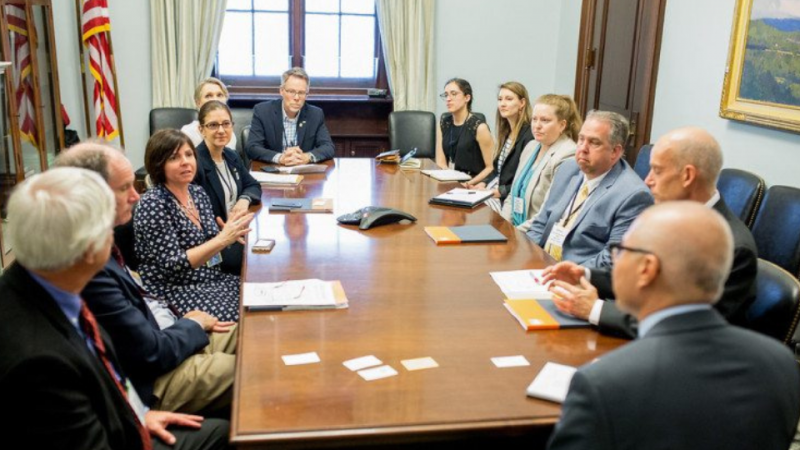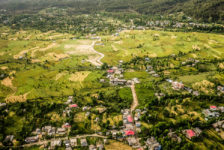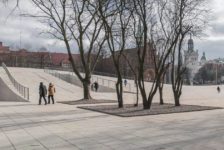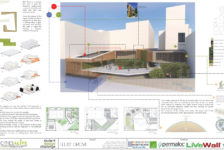Democracy operates on engagement and relationships. To elevate the profile of landscape architecture, the public outreach of the profession’s government affairs must move beyond the virtue based rationalization and create arguments that resonate and connect. Without effective involvement, landscape architects risk substantial economic costs and lessen the overall impact of our work. McKinsey and Company notes that, “the business value at stake from government and regulatory intervention is huge: about 30 percent of earnings for companies in most industries.” That figures roughly $630M in potential impact to landscape architecture design services nationally, using figures from a 2015 NEA Report. From fighting regulation battles to continual challenges of marketplace jurisdiction and scope, it is clear that landscape architects face an uphill climb.
In the Venn diagram of landscape architecture public outreach, politics and policymaking occupies a small overlap in the perception of the requirements of everyday practice. Couple that small allotment of time with the fact that we all, presumably, have day jobs that account for at least 40 hours a week, and family obligations as well as personal time that make up the rest of one’s schedule and a problematic pattern starts to emerge given the social, environmental, and economic impacts at stake. The space allotted to think about professional service through ASLA, let alone government affairs and advocacy, shrinks with each overwhelmed moment, making the job of advocacy all the more difficult and geared toward simply managing crisis. The cost of this current meager model is dire.
While it’s true that the space for this conversation is minute and currently limited to a subset of a few wonks, activism and advocacy are the most important and meaningful thing we can do as professionals. In order for landscape architects to make the type of impact we know the profession is capable of, we must create space for these interactions to seize the attention of policymakers.
Over half of the states have had some challenge to professional regulations and licensure in the recent years. The last few months alone have seen a dramatic uptick in the frequency of these attacks, mostly under the false pretense that licensure is unnecessary and that it serves as a barrier to otherwise qualified individuals to practice. At the same time ASLA fights state to state battles for the right to practice, the Federal Government Affairs team continually works toward maintaining the programs that employ landscape architects, making policymakers and allied coalitions aware of landscape architecture’s diverse role, while also uncovering opportunities for landscape architects to author our own legislation.
To compound the issues landscape architects face, the resurgence of Yellow Journalism does little to spur support for ASLA’s priorities. In a recent essay on how landscape architects adapt practice to realize the full potential of professional impact, I wrote, “The spectre of rhetoric from [the 2016 presidential] election will haunt us for generations.” The scandal and polarizing grandiloquent spurred deep political divides that make the typically bipartisan legislation ASLA supports frequently get lost in the shuffle or used as political bargaining chips. This actuality propels advocacy, making policymakers aware of the profession and its priorities, to a greater significance in the society’s public outreach efforts.

The Value of ASLA: Advocacy Day
Advocacy is the lens that I look at ASLA through. Why become a member of ASLA? Because the protection offered for my professional license and the economic impact to the work we do is tangible. Advocacy Day is one of the “boots on the ground” moments that showcase the value of membership. Each year, delegates and leaders from each chapter of ASLA gather in Washington D.C. for mid-year meetings (Chapter Presidents Council and the Board of Trustees) combined with a one day lobbying event on Capitol Hill. ASLA’s annual Federal Advocacy Day fly-in, the society’s premier advocacy event, involves legislative briefings and meetings with home state Congressional offices of the chapter delegates. Across all the meetings, the chapters each discuss common priorities, from introducing/re-introducing the profession to key legislation that comes from a combination of critical programs, member identified priorities, and leadership driven initiatives.
This year’s event took place in the shadow of a flurry of political activity, sucking up the already depleted supply of oxygen in Washington D.C. From the President’s debrief on North Korea that dramatically involved busing all Senators to the White House, a looming government shutdown due to the Federal budget priorities of ACA and border wall funding, the threat of selling off public lands, a large scale march for the Climate, all of which marked the first 100 days of the new administration. They each contributed to an atmosphere abuzz with nervous anticipation and uncertainty heading into a day full of meetings, where a significant number of delegates were first time participants.
Leading up to this year’s Advocacy Day involved a variety of preparation meetings including webinars and preparing elevator pitches because you never know who you’re going to run into waiting for an elevator in the Russell Senate office building – I actually ran into Ted Cruz myself. Besides familiarizing themselves with the issues, delegates were asked to focusing on telling stories, because as great as statistics are, in-district stories coupled with that information connect and resonate.
Then there was a fire on the DC Metro. With no time to get nervous and meetings with the policymakers scheduled throughout the day (2 Senate and 1 House meeting per delegate, across all of the different chapters, with at least three representatives per chapter), delegates quickly made alternate plans to travel from the hotel meeting room to Capitol Hill. This year, the overall message for each meeting was in consolidating the different advocacy focus areas around landscape architecture as necessary infrastructure. For me, this means discussing Efficacy vs Efficiency, systems thinking vs linear problem solving. In this way, landscape architects ensure that investments in public infrastructure have high ROI and wise spending of taxpayer dollars.
Three primary “asks” the delegates make in the various meetings with their Congressional representatives. These included upgrading to a multimodal transportation network through supporting TIGER Discretionary Programs. Adequate funding for this program allows landscape architects to successfully assist more states and local communities with building multimodal projects that address congestion, improve safety, and expand economic opportunity. Additionally, ASLA advocated for landscape architect’s role in fixing our nation’s water management systems through the EPA Clean Water State Revolving Funds. Specifically, the delegates requested their representatives to support increased funding for these funds, which will allow urban, suburban, and rural communities to utilize green infrastructure projects to address water issues. Lastly, the delegates sought further recognition for public lands, parks, and other recreation areas as to be defined as critical Infrastructure. To do this, the delegates asked each Congressional representative to cosponsor bipartisan legislation introduced in the House and Senate to permanently authorize and fully fund the Land and Water Conservation Fund.
The day was capped off with Representative Earl Blumenauer addressing the delegates as everyone regrouped and shared stories of their experiences. Congressman Blumenauer is especially involved in the Congressional Bike Caucus as well as the Trails Caucus, so his familiarity with the work of landscape architects was refreshing. His call for continued engagement and enthusiasm succinctly encapsulated the day and served as a launchpad for future Advocacy Days.
What’s Next: Going on the Offensive
Between the schisms of party politics, the exhausting barrage of elections, and the tedious legalese language of actual policy – concluding that government affairs is best left to more enthusiastic practitioners is all too common. While uncertainty continues to arise from contemporary political decisions, this must impel us to the action that Ernie Wong concludes in his call to action, “Landscape Architects and Civic Engagement.”
After the blitz of Advocacy Day, landscape architects have the the responsibility of continued active engagement with policymakers, maintaining and building relationships, and serving as resources on important (and related) concerns. During our representatives in-district time, we have the opportunity to not only attend town hall meetings, but showcase the value of landscape architecture through Site Tours (ASLA has a handy guide for that).

ASLA chapters have often promoted landscape architecture month through municipal and statewide Proclamations and Resolutions, where we author the language (Pro-Tip: Include a statement about the public health, safety, and welfare) that can then be used to demonstrate support of the profession should the need arise. These do not have to be one off events, but used within advocacy packets to continually showcase support of the profession from policymakers. Additionally, discussing landscape architecture as public infrastructure will help fundamentally change the tone of the profession’s message: from luxury to necessity. A small shift in thinking that will help landscapes advocacy across political divides. The profession will need a combination of these tactical approaches to fully leverage our capabilities and unique world view.
I have said before but it is worth repeating, “if we take our oath of stewardship seriously and embrace the declarations of the next generation of landscape architecture we have to do more. To do this work successfully, we must advocate at every level of government with clarity, consistency, and insight.” The space landscape architecture meagerly occupies within the government affairs and political dialogue is undersized and the cost of that is dire. Connecting business issues to virtue based concerns, landscape architects increase their understanding of the regulatory value at stake with government affairs.
Published in Blog, Cover Story, Featured









